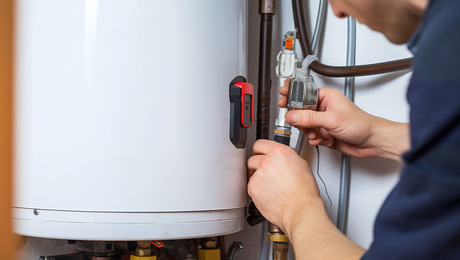I’m putting radiant heat in a new house project that we’re starting later this summer. I would like tubing on top of subfloor covered with something like gyp-crete therma floor. The kicker is, the nearest gyp-crete dealer is 3 hours away. What type of installations do you use and what products do you recommend? The normal installation in this area is under the floor.
Discussion Forum
Discussion Forum
Up Next
Video Shorts
Featured Story

Learn more about the benefits and compliance details for the DOE's new water heater energy-efficiency standards.
Featured Video
How to Install Exterior Window TrimHighlights
"I have learned so much thanks to the searchable articles on the FHB website. I can confidently say that I expect to be a life-long subscriber." - M.K.

















Replies
We are in the ice-cold Adirondacks, and most everyone does staple-up-under in wood floor frame construction. We then use a foil-faced foamboard insulation fixed in place to create a 1-1/2" deep cavity that houses the tubing runs.
I have seen some tile-floored baths get a warmboard-type product on top of the subfloor, then tubing in the runs, before finish tile.
I am looking at a job right now with gypcrete specified, and have no idea how to get a contractor here to do it.
E Jayne and Bob: How about mixing the gypcrete on site? Not as good as the plant mixing it if the plant is close. But much better than getting 3-hour-old concrete that has already lost much of its strength.
As with any site-mixing, there is a tendnecy to use too much water and get too much slump. Too much water makes weaker concrete.
But, aware of those limitations, couldn't it be mixed in the truck, on site?
They don't use 3 hour old concrete. It's mixed on site with my water and my sand. With travel time they want $3.50 a square foot. That's $7000 for 2000ft for just the pour.
Ask the gypcrete contractor if he can do it and how much he charges for travel time. I think the gypcrete is the way to go. It is a brand name so there may be other contractors with a clone product a little bit closer. Ask local plumbers or contractors that specialize in RFH. I don't reccommend mixing it on site by yourself. The guys that are outfitted with the gypcrete have pumps and mixers that cost hundreds of thousands.
I am living in a home with gypcrete and there is no comparision. The other methods you describe have no thermal mass so when the power goes out there is no residual heat. Even with the foil, the warm board is a very poor conductor so it will take more power to make the same amount of heat. They are not as efficient and probably not any cheaper to install either. Without the thermal mass, RFH is a joke in my opinion. No self respecting builder in my area would install RFH without the thermal mass. There are a lot of radiant system homes in my area. No one uses anything but gypcrete for RFH except in bathrooms as supplemental heat when there is forced air everywhere else. Then it is usually an electrical mat installed under tile.
We don't need air conditioning in the summer so the mechanical expense is a little less.
If this is your home then you should go with the gypcrete because it is much more comfortable and you don't have all that dust blowing around and all that noise. It is more expensive to install but you don't have drop ceilings everywhere to accommadate the ducting, the crawl space isn't choked with ducting and the sheet metal contractor isn't running around with the chainsaw when your not watching, hacking the place to pieces.
Go with 6mil poly or tar paper, mesh screen, staple down tubing then mud it all in with min 3/4" above tubing. Install crack isolation membrane then tile your heart out.